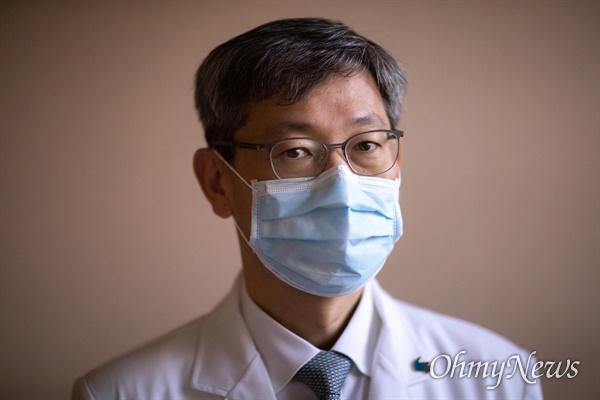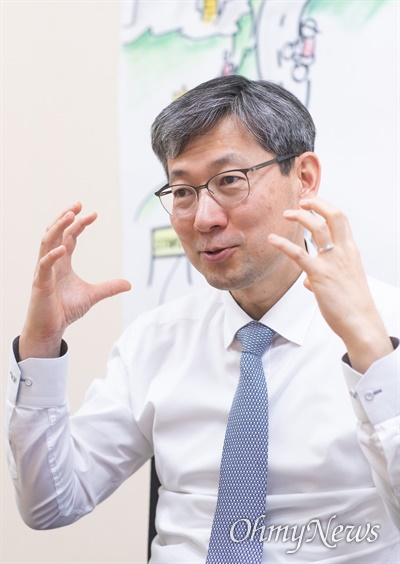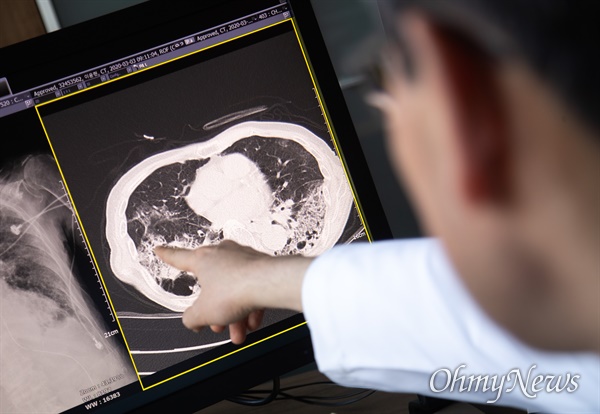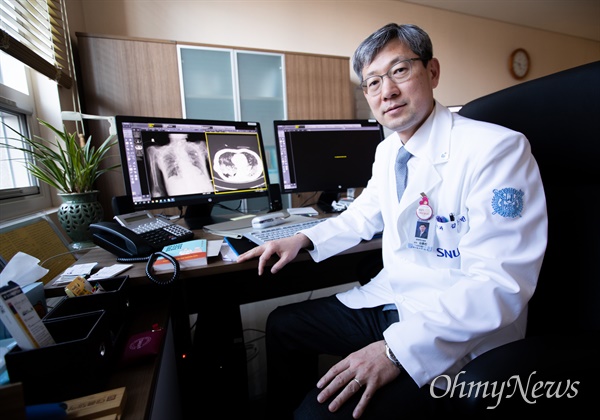| Since the first confirmed case on January 20th in Korea, the whole nation has been suffering from the COVID-19 for 2 months by the upcoming March 19th. OhmyNews diagnoses the current spread of COVID-19 with the analysis of deaths, timelines and re-meeting experts on the issue.[편집자말] |
큰사진보기

|
| ▲ Prof. Kim Hong-bin, Division of Infectious Diseases at SNU Bundang Hospital |
| ⓒ Lee Hee Hoon | 관련사진보기 |
"It seems to be in a stable period, but it's kind of an illusion effect."
Recently the number of COVID-19 confirmed cases a day fell below 100 quite often. Compared to last week, when the daily confirmed cases hit hundreds, COVID-19 spread seems to have slowed down. Then, is COVID-19 dying away now? Kim Hong-bin, Prof. at the division of infectious diseases at SNU(Seoul National University) Bundang Hospital, stressed that it is not.
Prof. Kim Hong-bin pointed out that the number of confirmed cases in the Seoul metropolitan area has not decreased at all in the past one or two weeks. He said, "The surge in patients was due to the variable of Shincheonji collective infection."
<OhmyNews> first met Prof. Kim a month ago on February 18th. It was also the day when the first COVID-19 confirmed case (No. 31) came out in Daegu, and the first day of the mass infection in Daegu Shincheonji church. He said at the time, "It was expected by all experts that there would be infected patients in the communities. Now, we have to face the expected phase and develop the strategy necessary for the situation."
The reality, however, exceeded the expectation. On the 17th, we met Prof. Kim again in a month and this is what he said.
"None of the experts expected there would be so many patients coming out in one day. We had a strategy to cope with community infections, but with the current medical system, we couldn't handle the surge in the number of patients. At least if things had happened within our reach, some of the deaths wouldn't have met their ends like that. I really feel sorry about them."
The followings are the questions and answers with Prof. Kim.
Illusion Effect Caused by Shincheonji Collective Infection
큰사진보기

|
| ▲ Prof. Kim Hong-bin, Division of Infectious Diseases at SNU Bundang Hospital |
| ⓒ Lee Hee Hoon | 관련사진보기 |
- The growth rate of COVID-19 confirmed cases has decreased significantly recently. What kind of situation do you think it is now?
"It seems to be in a stable period at first glance, but it's kind of an illusion effect. The surge in patients was due to the unexpected variable of the collective infection at Shincheonji church in Daegu. The graph including the number shows that the number of confirmed cases has increased significantly and then decreased. When we look at it, it gives us the idea of going back to the normal life we've dreamed of.
But that's not true. We have to see the situation in other areas besides Daegu and Gyeongsangbuk-do Province. Seoul metropolitan areas including Gyeonggi-do Province and other provinces haven't shown any decrease in the number of confirmed cases in the past 1~2 weeks. On the contrary, the confirmed cases increased in Seoul due to the outbreak of group infections. This means that things have not improved overall, considering that the metropolitan area is about half of the total population. It is not a safe stage yet. If we let our guard down, a large-scale infection will occur again."
- What's happening in the field now? In the previous interview a month ago, you criticized that "the government doesn't have enough capacity to handle it yet" or "you are in a situation suffering in the field."
"The same is true now. The government's job is to ensure that strategies and principles can be implemented in the field. However, I don't feel that the medical system is working like a cog in the field. This is still the same as it was during MERS."
- Specifically, what's the problem?
"According to the government's announcement, it seems that they have already secured enough beds. However, the figures and the actual operating rates are different. For example, SNU Bundang Hospital alone has about 1,300 beds, of which 60 to 70 are not available. This is because the surrounding beds were closed to create negative pressure rooms. Many hospitals are in the same situation. We need to make up for the fall of the bed operating rate so that we can deal with emergency situations immediately.
We also need to organize systematically to send patients to where according to their symptoms. For example, we have to sort out the patients with minor, intermediate, and severe stages and plan to send them to the designated hospitals based on their stages. This part is still lacking in both central and regional areas."
- Has the quarantine system been reorganized through the situation in Daegu and Gyeongsangbuk-do Province?
"Of course, it's better compared to the beginning. However, to respond to community infections properly, I think there is still much to be desired. The reason why the related problems were not so prominent in other regions was that there weren't any similar amount of confirmed cases in Daegu and Gyeongbuk. I don't think other places will be able to cope properly if there are surges in patients in their cities or towns."
Patient No. 25, the Subject of Controversy
큰사진보기

|
| ▲ Prof. Kim Hong-bin, Division of Infectious Diseases at SNU Bundang Hospital is explaining the lung state of a COVID-19 patient. |
| ⓒ Lee Hee Hoon | 관련사진보기 |
- The COVID-19 situation has progressed rapidly over the past two months. Did you have anything you didn't expect?
"We didn't expect Shincheonji collective infections at all. No one expected so many patients to pour out overnight. Of course, community infections were expected. Therefore, we devised a strategy by securing beds or clarifying the medical delivery system. The current medical system, however, could not handle such a sharp increase in the number of patients. At least if things had happened within our reach, some of the deaths wouldn't have met their ends like that. I really feel sorry about them."
- As you know, controversy flared up about the 25th patient, because he was discharged from SNU Bundang Hospital in on Feb. 29th, but diagnosed with 'reconfirmed' again later.
"The test results were neither a recurrence(reactivation) nor reinfection. The RT-PCR test(Real-time Reverse Transcription Polymerase Chain Reaction test) was conducted four to five times and the results were all negative. At first, we thought that his immune system had decreased and the virus that was left in his body had returned. So we retested him several times. However, the PCR test shows that the virus levels kept going back and forth between positive and negative. This case is called the "undetermined." In this case, we usually judge that there are no living viruses. German researchers also submitted a paper on this, and their conclusion is the same. In this case, we conclude that there is usually no virus."
- Does it mean that the positive results from the PCR test don't necessarily mean there's a virus?
"You can say that. People often misunderstand this. The PCR is not a way to detect live viruses, but a way to detect genes. In some cases, the genes of the dead virus remain in the respiratory tract just as human genes can be detected in a dead body. In this case, even if there is no live virus, if a tiny fragment of the virus genes is left, it amplifies and shows the positive result in the PCR test."
- An employee at SNU Bundang Hospital was diagnosed with COVID-19.
"That person has been discharged. I don't know whether the employee will return to work or not yet. Immediately after that person was confirmed to have been infected, the other employees classified as "close contacts" self-quarantined for two weeks. Those who came into contact with the employee were also examined for COVID-19. Some parts of the hospital had to be closed. As a result, some of the treatments were paralyzed. The biggest problem here is the mental burden that the confirmed person will feel. The critical gaze at the confirmed patient must be very harsh to bear, regardless of how he or she became infected."
- What do you mean by 'critical gaze'?
"It's a social stigma caused by opening his or her personal movements. He or she was infected unavoidably but many people believe that the infected person harms so many others. Even some local governments continued to send such individual movements through disaster text messages. When an individual's daily life is made public in this way, the psychological damage that the infected person will receive can also be considerable."
- The revealing of the movements was carried out for the first time for COVID-19. What's your position on this?
"Of course, it is necessary to open the confirmed patients' movements, but doing it excessively is a problem. Because the personal information was revealed, some innocent people were harmed. In fact, some patients who were about to leave the hospital could not return to their homes even though their condition had already improved. It's because their houses have already been opened."
The World after COVID-19
큰사진보기

|
| ▲ Prof. Kim Hong-bin, Division of Infectious Diseases at SNU Bundang Hospital |
| ⓒ Lee Hee Hoon | 관련사진보기 |
- What's the status of the medical workers in the field?
"'Holding up' would be the correct expression. It has already been more than two months since the war against COVID-19 began. Treating the confirmed patients, the staff's physical and mental fatigue has been accumulated significantly. Moreover, there is a lot of pressure on the possibility of being infected. Our biggest concern is how much longer we can sustain this life and endure it."
- What about the supply of medical equipment?
"It's not enough. Many medical workers, including myself, wear surgical masks (disposable ones, not quarantine masks). And even the surgical masks are not enough for all hospital staff to use. Therefore, masks are given according to priorities (high probability of infection). Some doctors in the operating rooms have to wear cloth masks. They are the replacement for surgical masks, which are used by tying the strings behind the head. When the supply and demand of the masks were not smooth, the government had to draw the right supply based on sufficient social consensus. This part is a bit unsatisfactory."
- KCDC recently predicted that COVID-19 will be "a long-term one" and that we should prepare for "a new pattern of daily life".
"I also joke around and say, 'We have to find a way to co-exist with the virus.' In fact, an unspecified number of patients have been infected, or there are many patients we can't find the connections with the infection. I think we have no choice but to take this situation and maintain our daily lives until a large portion of the population acquires immunity."
- Some argue that COVID-19 will become endemic.
"That's quite possible. Since it is a new virus, it will go around among people until the immune system is in place. So, we have no choice but to maintain social distancing to avoid infection until we eventually become immunized or cure or vaccines are developed."
- What is the 'new daily life' we have to prepare for in the future?
"Many people say 'the world before and after COVID-19 will be so different.' Using this opportunity, we have to save what is to be saved, but we have to reflect on and improve something that needs to be changed in our society. First, the practice pattern for diagnosing respiratory patients needs to be changed. People with fever and respiratory symptoms should be treated separately. Also, the working environment should be improved. The working condition of the call center revealed this time is an example. They should improve the over-dense working environment and enable a significant portion of telecommuting. More than anything else, a working culture should be created. We must take a rest when we are ill."
Written by Kang Yeon Joo
Photo by Lee Hee Hoon
Translated by Youngae Joanna Kim.
* This report is the English version of OhmyNews Korean article. If you want to read the original article in Korean, click here!